Every year, on August nights, the sky witnesses a wonderful sight—the Perseid meteor shower. This is the time when suddenly, in the deep darkness of the night, a bright streak pierces the sky and disappears in no time. Sometimes these streaks are so long and bright that they remain in the eyes for a few seconds.
People also call it a “shooting star,” and in many cultures it is believed that if a person hasa wish in mind when a meteor falls, it is fulfilled. Although science sees it differently, in terms of thrill and beauty, this scene is no less than a dream.
Why will this year’s Perseid meteor shower be different?
Bill Cook, head of NASA’s Meteoroid Environments Office, said that during the Perseid meteor shower, usually 40–50 meteors are visible per hour, but this year this number may be reduced to 10–20 per hour.
The biggest reason for this is the full moon of August. The bright light of the moon masks the lighter and smaller meteors, leaving only the brightest meteors visible. According to Bill Cook:
“If the sky was dark and clear, you could see an average of 40–50 Perseid meteors per hour, but this time the number will be less than half because of the moon.”
Expert estimates
Robert Lunsford, an expert from the American Meteor Society, says that most meteors this year will be faint, making them difficult to see in moonlight. He estimates that even at the peak of the meteor shower, no more than 15 meteors per hour will be visible on average.
He also said that you can start seeing meteors as early as 10 pm, especially “Earth grazers“—meteors that travel long distances from near the horizon and look extremely beautiful. However, as the night progresses and the moon comes up, visibility will decrease.
Time and duration of Perseid meteor shower
According to Finn Burridge, science communicator at the Royal Observatory Greenwich, the peak time of the Perseid meteor shower in 2025 will be the night of 11–12 August and 12–13 August. But meteors can be seen till 23 August.
Key dates:
- Start: from around 17 July
- Peak time: 11–13 August
- End: around 23 August
The speed and frequency of meteors in the sky is high at peak time, but this year this number will be limited due to the position of the moon.
The right way to see the meteor shower
If you want to enjoy the Perseid meteor shower, keep these things in mind:
- Choose a dark and open place—artificial light of the city (light pollution) reduces the ability to see meteors.
- Best time—early morning hours (2 am to sunrise) when the sky is the darkest.
- Direction—Do not look in the direction of the moon, but keep an eye in the northeast direction.
- Eye adjustment—Avoid brightly lit devices (mobile, torch) 20–30 minutes before watching the meteor shower so that the eyes can adjust to seeing in the dark.
- Comfortable preparation—Lie down with a reclining chair or sheet so that the neck can look at the sky for a long time without getting tired.
Science behind the Perseid meteor shower
Meteor showers occur when the Earth passes through a strip of dust, ice and small pieces of rocks left by a comet or asteroid. When these particles enter our atmosphere, they start burning due to intense friction and heat and appear as bright streaks.
The source of the Perseid meteor shower is Comet Swift–Tuttle, which orbits the Sun once in about 133 years. When Earth passes through the path of the debris left behind, meteor showers occur.
Speed and energy:
- Speed: 59 kilometers per second (about 37 miles per second)
- Size: From a grain of sand to a pebble
- Burning time: Less than a second, but the glow lasts for several seconds.
History and cultural significance
The earliest mention of the Perseid meteor shower is found in ancient Chinese texts from about 2,000 years ago. In Europe, it was called the “Tears of Saint Lawrence” because the phenomenon occurred every year around August 10, the feast day of Saint Lawrence.
In many cultures, meteors are considered auspicious and wishes made during them are believed to come true. Although, from a scientific point of view, it is only an astronomical phenomenon, its beauty and mystery make it special.
Why the Perseid meteor shower is most popular
- It occurs in the summer, when the weather is pleasant.
- It is one of the most visible meteor showers in the Northern Hemisphere.
- The brightness and long-distance streaks of the meteors make it special.
Conclusion
Although the Perseid meteor shower in 2025 will be slightly less impressive in the moonlight, it is still a natural show in the sky that can last a lifetime. With the right time, the right place and a little preparation, you can enjoy this amazing phenomenon.
If you want to feel the vastness and beauty of the universe, watch this year’s Perseid meteor shower—even if there are fewer meteors, the experience will be just as special.
FAQs
Q. What is the Perseid meteor shower?
A. It is an annual meteor shower caused by debris from Comet Swift–Tuttle burning up in Earth’s atmosphere.
Q. When does the Perseid meteor shower peak in 2025?
A. It peaks on the nights of August 11–12 and August 12–13.
Q. How many meteors can I see this year?
A. Due to the bright moon, you may see only 10–20 meteors per hour instead of the usual 40–50.
Q. What is the best time to watch?
A. The early pre-dawn hours, when the sky is darkest and away from bright city lights.
Q. Do I need special equipment to watch?
A. No, you can watch with the naked eye—just find a dark, open spot and look up.


